Chapter: 11th Botany : Chapter 1 : Living World
Kingdom : Myceteae (Fungi)
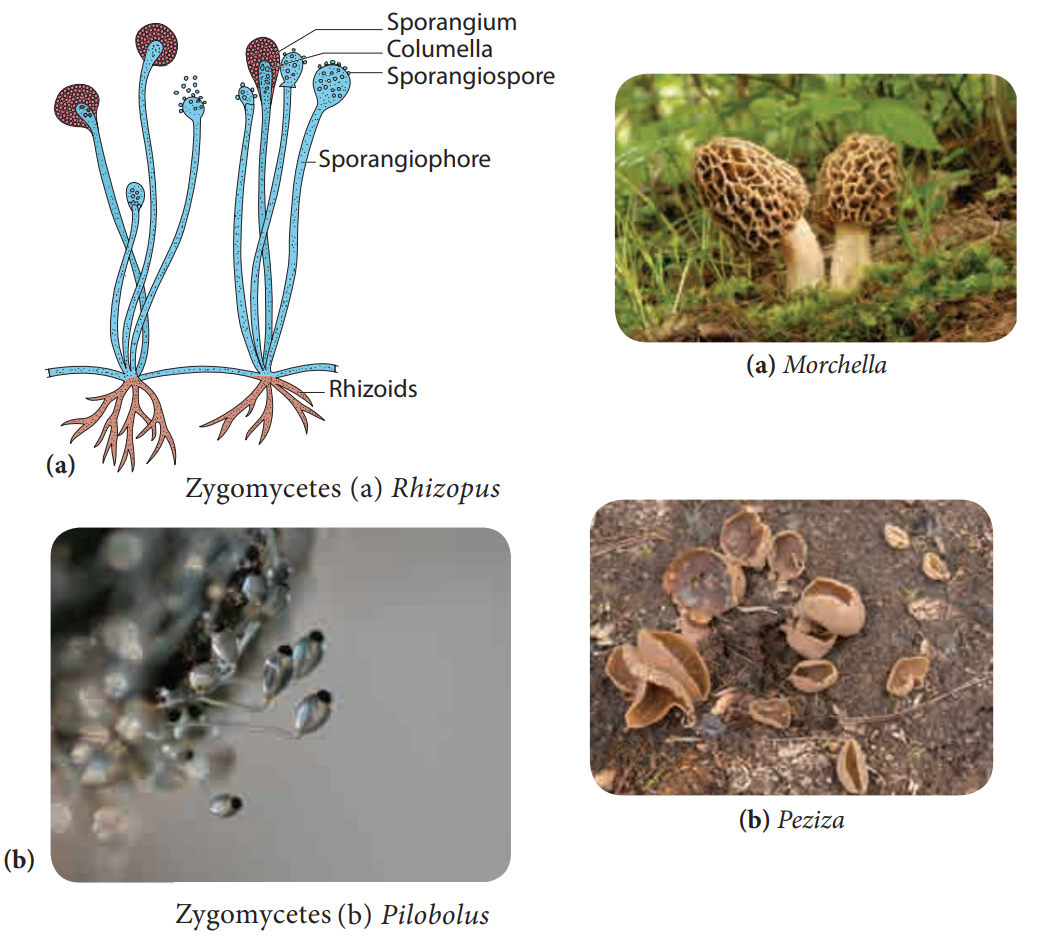
Kingdom : Myceteae (Fungi)
Include achlorophyllous, saprophytic or parasitic
organisms with Unicellular or multicellular (Mycelium) thallus surrounded by
chitinous cell wall. Nutrition is absorptive except slime molds.Reproduction is
through asexual and Sexual methods.
Division : I Gymnomycota
Nutrition Phagotrophic, members of this group lack
cell wall. Example. Dictyostelium
Division :II Mastigomycota
Flagellate
cells are present(Gamete/ Zoospore) . Nutrition
absorptive, mycelium coenocytic. Example : Albugo
Division : III Amastigomycota
Unicellular to multicellular forms are included.
The mycelium is septate.
Asexual reproduction occurs by budding,
fragmentation, sporangiospores, conidia etc., Meiosis is zygotic. Example : Peziza
Recently, with the advent of molecular methods
myxomycetes and oomycetes were reclassified and treated under chromista.
Oomycetes
Coenocytic mycelium is present. The cell wall is
made up of Glucan and Cellulose. Zoospore with one whiplash and one tinsel
flagellum is present. Sexual reproduction is Oogamous. Example: Albugo.
Zygomycetes
•
Most of the species are saprophytic and live on
decaying plant and animal matter in the soil. Some lead parasitic life
(Example: Entomophthora on housefly)
•
Bread mold fungi (Example: Mucor, Rhizopus) and
Coprophilous fungi (Fungi growing on
dung Example: Pilobolus) belong to
this group (Figure 1.21).
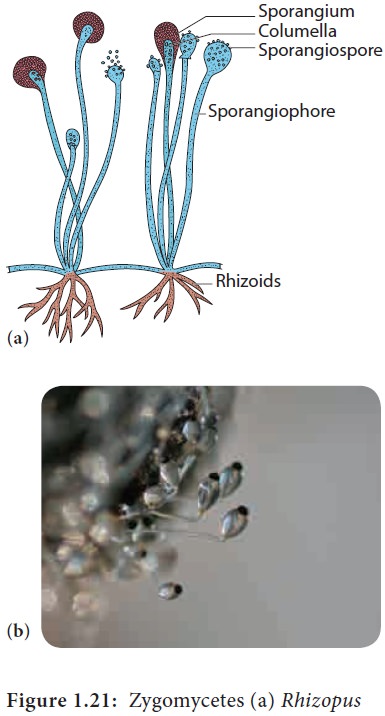
• The mycelium is branched and coenocytic
•
Asexual reproduction by means of spores produced in
sporangia.
•
Sexual reproduction is by the fusion of the
gametangia which results in thick walled zygospore. It remains dormant for long
periods. The zygospore undergoes meiosis and produce spores.
![]()
![]()
![]()
Ascomycetes
• Ascomycetes
include a wide
range of fungi such as yeasts, powdery mildews, cup fungi, morels and so
on (Figure 1.22).

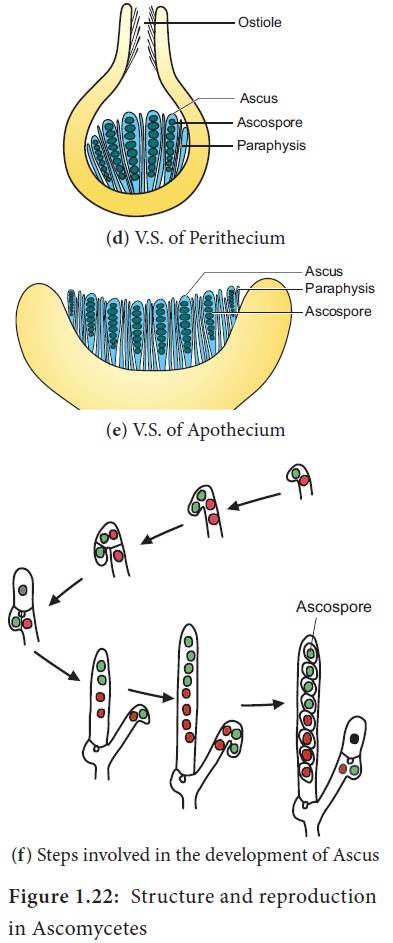
•
Although majority of the species live in
terrestrial environment, some live in aquatic environments both fresh water and
marine.
•
The mycelium is well developed, branched with
simple septum.
•
Majority of them are saprophytes but few parasites
are also known (Powdery mildew – Erysiphe).
•
Asexual reproduction takes place by fission,
budding, oidia, conidia, chlamydospore.
•
Sexual reproduction takes place by the fusion of
two compatible nuclei.
•
Plasmogamy is not immediately followed by
karyogamy, instead a dikaryotic condition is prolonged for several generations.
•
A special hyphae called ascogenous hyphae is
formed.
•
A crozier is formed when the tip of the ascogenous
hyphae recurves forming a hooked cell. The two nuclei in the penultimate cell
of the hypha fuse to form a diploid nucleus. This cell form young ascus.
•
The diploid nucleus undergo meiotic division to
produce four haploid nuclei, which further divide mitotically to form eight
nuclei. The nucleus gets organised into 8 ascospores.
•
The ascospores are found inside a bag like
structure called ascus. Due to the presence of ascus, this group is popularly
called "Sac fungi".
•
Asci gets surrounded by sterile hyphae forming
fruit body called ascocarp.
•
There are 4 types of ascocarps namely Cleistothecium (Completely closed), Perithecium (Flask shaped with ostiole), Apothecium (Cup shaped, open type) and Pseudothecium.
Basidiomycetes
•
Basidiomycetes include puff balls, toad stools,
Bird’s nest fungi, Bracket fungi, stink horns, rusts and smuts (Figure 1.23).
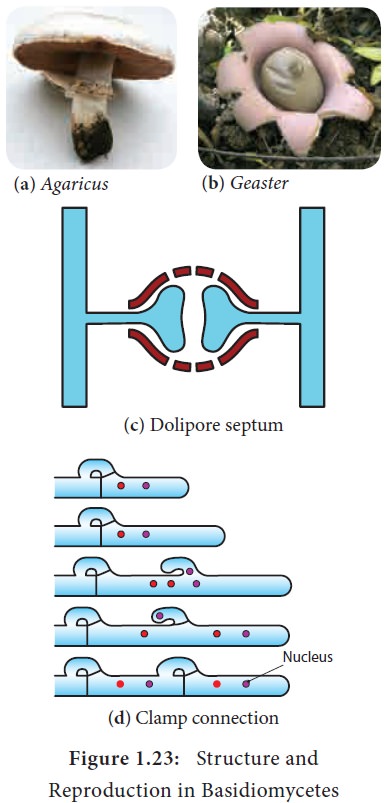
•
The members are terrestrial and lead a saprophytic
and parasitic mode of life.
•
The mycelium is well developed, septate with
dolipore septum(bracket like). Three types of mycelium namely Primary
(Monokaryotic), Secondary (Dikaryotic) and tertiary are found.
• Clamp connections are formed to maintain dikaryotic condition.
•
Asexual reproduction is by means of conidia, oidia
or budding.
•
Sexual reproduction is present but sex organs are
absent. Somatogamy or spermatisation results in plasmogamy. Karyogamy is
delayed and dikaryotic phase is prolonged. Karyogamy takes place in basidium
and it is immediately followed by meiotic division.
•
The four nuclei thus formed are transformed into
basidiospores which are borne on sterigmata outside the basidium (Exogenous ).
The basidium is club shaped with four basidiospores, thus this group of fungi
is popularly called “Club fungi”. The fruit body formed is called Basidiocarp.
![]()
![]()
![]()
Deuteromycetes or Fungi Imperfecti
The fungi belonging to this group lack sexual reproduction and are called imperfect fungi. A large number of species live as saprophytes in soil and many are plant and animal parasites. Asexual reproduction takes place by the production of conidia, chlamydospores, budding, oidia etc., Conidia are also produced in special structures called pycnidium, Acervulus, sporodochium and Synnema (Figure 1.24). Parasexual cycle operates in this group of fungi. This brings genetic variation among the species.
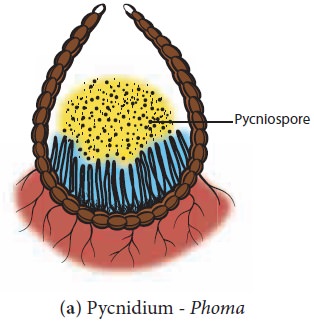
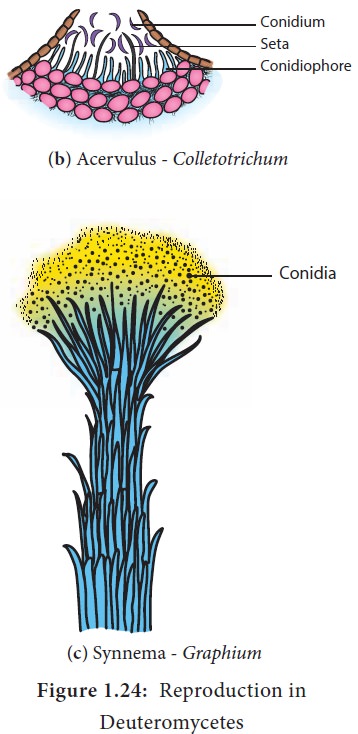
Related Topics